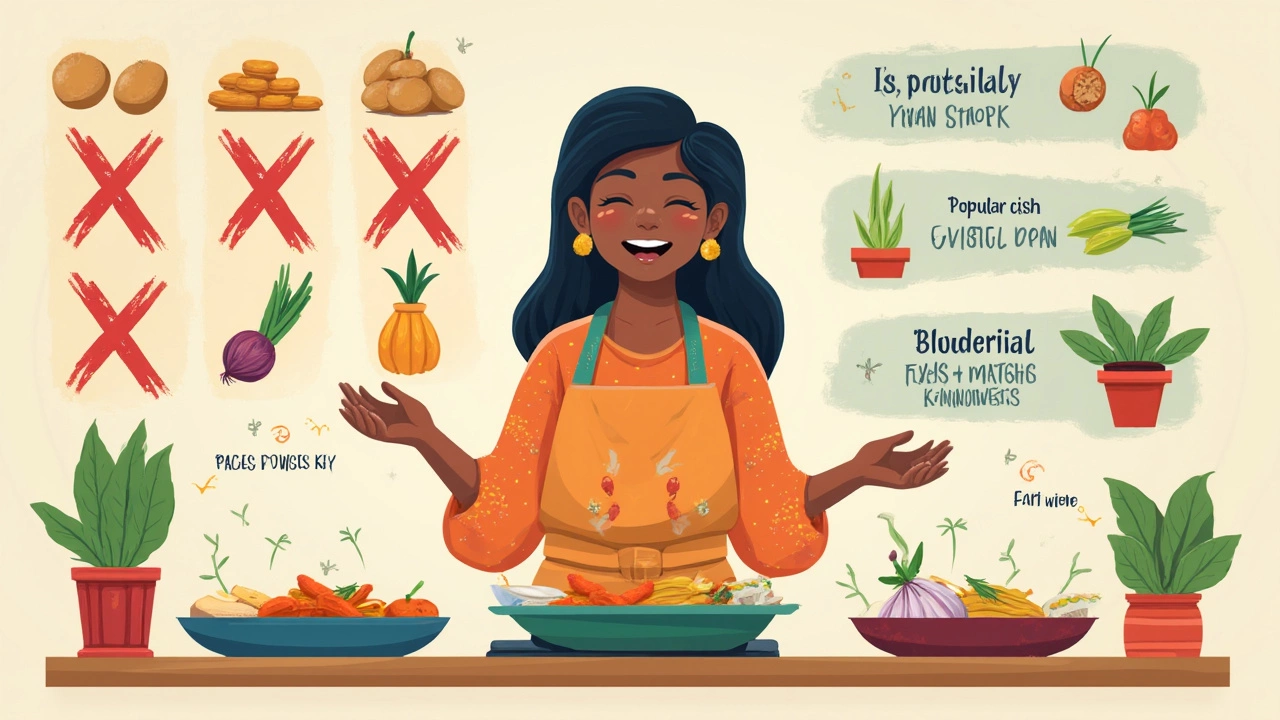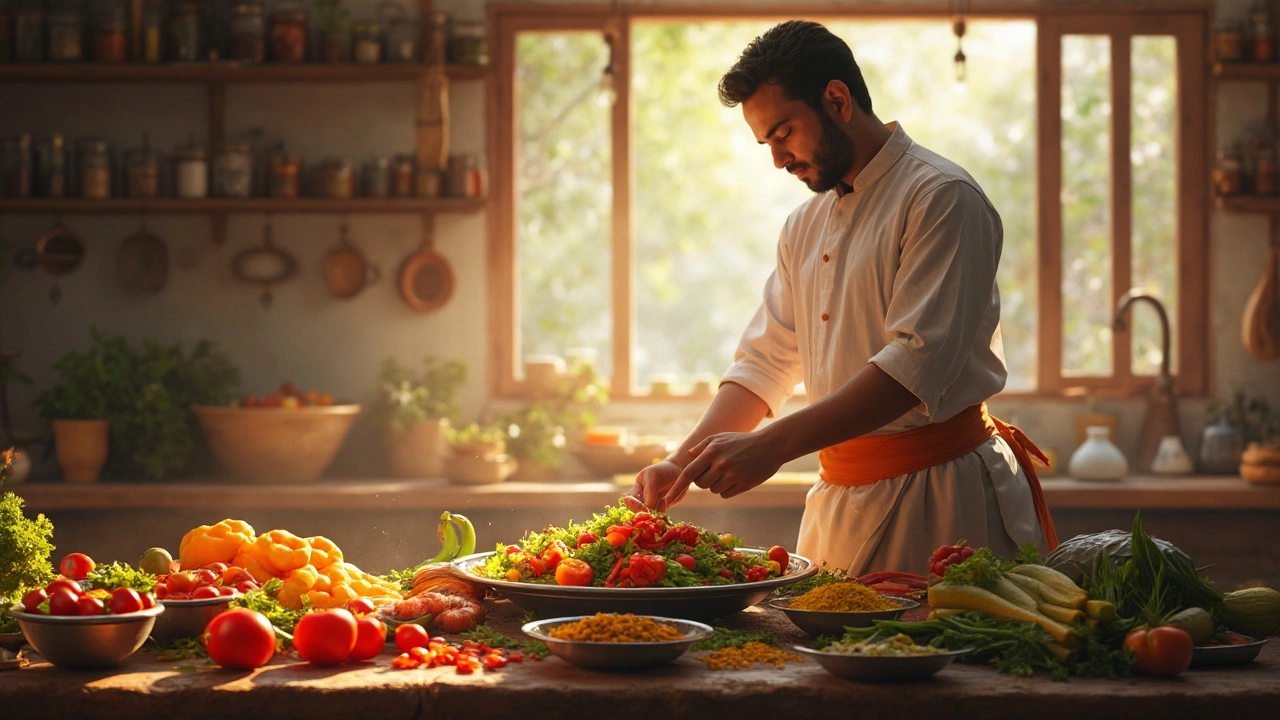Ever hit an Indian restaurant and wondered why the Jain section skips all the usual suspects like potatoes? It's not because they don't like aloo—in fact, it's a total diet rule. Jains stick to a pretty strict set of guidelines, and potatoes just don't make the cut.
If you’re used to tossing potatoes into every curry, samosa, or dosa, this might sound wild. But in Jainism, eating root veggies (yes, that includes onions, garlic, and carrots, too) isn’t just about preference—it's about not harming tiny life forms and the plant itself when digging these veggies up. So, no, Jains don’t eat potatoes, and the reason is a lot deeper than you might think.
Curious how they fill those potato gaps and still make incredible food? You’ll want to know their veggie swaps and some sneaky tips for classic Indian recipes that don’t need potatoes to taste great.
- Why Potatoes are Off-Limits for Jains
- The Logic Behind Avoiding Root Vegetables
- What Jains Do Eat Instead
- Tips for Making Jain-Friendly Indian Food
- Surprising Dishes That Already Fit Jain Rules
Why Potatoes are Off-Limits for Jains
If you ask anyone who follows Jainism, they’ll tell you this plainly: potatoes are a straight-up no-go. The reason isn’t about taste or allergies—it's all about their religion’s rules around minimizing harm to living beings. Jainism takes non-violence (ahimsa) deeper than most: it’s not just about skipping meat. Even plants get special treatment.
Here’s the deal—when Jains pull a root vegetable like a potato out of the ground, the entire plant is uprooted or heavily hurt. Pulling up potatoes kills the plant, and Jains believe this action destroys a ton of microscopic life that lives on and around those roots. Not only that, potatoes and other tubers are packed with these tiny organisms, which are basically invisible bugs and little root creatures. That goes against the heart of Jain food ethics.
There’s also the issue of regrowth. Unlike picking fruit or leafy greens (where the plant keeps growing), digging up roots means there’s nothing left behind to grow. So, for a Jain, eating a potato isn’t a harmless snack—it’s a big step away from their core values.
- Potatoes, onions, garlic, carrots, beets, turnips—these are all off-limits to Jains for the same reason.
- Even at family gatherings, you won’t see a Jains plate with potato sabzi or samosas if everyone’s sticking to the rules.
For a little perspective, look at this chart showing what’s usually okay and what’s typically a no in a Jain kitchen:
| Veggie Type | Jain-Friendly? |
|---|---|
| Potatoes | No |
| Cauliflower | Yes |
| Carrots | No |
| Peas | Yes |
| Onions | No |
| Tomatoes | Yes |
This root-avoidance isn’t just at home—it shows up in restaurants, festivals, everywhere. And it’s been a core practice for centuries, not just some modern health kick.
The Logic Behind Avoiding Root Vegetables
The main reason Jains avoid root vegetables boils down to a strict belief in non-violence, or ahimsa. This isn’t just about not hitting people—Jains take it way further to cover all living things, including the tiniest of organisms. When you pull up a root vegetable like a potato, carrot, or radish, you’re not just taking the veggie. You’re disturbing soil, harming bugs, and yanking out the entire plant so it can’t grow back.
Jains go out of their way to keep their diet in line with this core principle. Roots and tubers, including potatoes, onions, garlic, sweet potatoes, and beets, are all off the table. Leafy greens, peas, and most beans, though? Fair game, since picking them doesn’t kill the whole plant.
Here’s a quick look at why it matters so much:
- Pulling root veggies kills the entire plant, while harvesting most fruits or leaves lets the plant keep growing.
- Soil around roots is packed with tiny life forms, which get killed during harvesting.
- Root crops are seen as less 'ahimsa-friendly' compared to above-ground veggies.
Jains also go as far as skipping certain foods during monsoon season, when the ground is full of microbes and bugs. The goal is to keep harm as close to zero as possible.
For those new to Jain food traditions, it might seem extreme. But it’s a clear way to practice non-violence in daily life, and avoiding root veggies is one of the most visible signs of it.

What Jains Do Eat Instead
So if Jains pass on potatoes and other root veggies, what’s actually on their plate? Good news for anyone curious—there’s way more variety than you might guess. Instead of root vegetables, Jains focus on foods that grow above the ground and don’t involve destroying the plant when harvested.
You’ll see a lot of gourds, squashes, beans, cucumber, leafy greens, cauliflower, and tomatoes in Jain kitchens. Staples like rice, wheat, dal (lentils), and milk products are all fair game. Instead of relying on potatoes for texture or creaminess, Jains often use raw bananas (plantains), pumpkin, or bottle gourd (lauki)—especially in curries and dry sticks.
Here's a quick look at some common Jain-friendly swaps that work well in Jain food rules and everyday Indian dishes:
- Raw banana (plantain): Besides being super filling, it holds its shape well in cutlets, curries, and koftas, making it a top-level potato substitute.
- Bottle gourd (lauki): This one’s everywhere in the summer, perfect for soups, sabzis, and even sweets.
- Papaya: Raw green papaya is kind of a secret weapon. Throw it in subzis and you’ll get a texture similar to potato.
- Cabbage and cauliflower: These guys step in when you need volume or bulk—think in samosas and stuffed parathas.
- Pumpkin (kaddu): Sweet and versatile—you’ll find it in Jain curries, halwa, or even kofta balls.
- Peas and sweet corn: For color, protein, and a bit of sweetness, these always make the cut.
Anyone who’s ever been to a Jain thali restaurant can vouch for the creative combinations. Jain cooks love “innovation within limits.” As food writer Priya Krishna once explained,
“Jain cuisine proves that delicious food comes from constraints. The lack of root vegetables and onions really brings out the creativity in Indian home kitchens.”
Out in the world, you’ll also spot Jain versions of street foods. That sabzi in your Dahi Puri? Could be made with mour (raw banana), skip the potato and you won’t even notice the difference.
One interesting stat—about 5 million people in India follow Jain dietary guidelines. It means there’s real demand for these potato-free swaps at both home and in restaurants. So when you scan a menu and see dishes labeled “Jain,” it’s not missing out, it’s just working its own flavor magic with things that grow above the dirt.
Tips for Making Jain-Friendly Indian Food
Making Indian food that's Jain-friendly takes more than just skipping meat. The secret is to avoid all root vegetables and underground stuff like potatoes, onions, garlic, carrots, radishes, and beets. Focus on what you can use instead and some recipes just need simple swaps.
- Use vegetables like pumpkin, squash, bell peppers, green beans, peas, and zucchini. These all grow above the ground and keep your dish aligned with Jain rules.
- Want to skip potatoes in samosas, curries, or pav bhaji? Try boiled raw bananas, plantains, or diced bottle gourd (lauki). They give a similar texture with way less fuss.
- When making tadka (tempering), avoid onion and garlic. Grab a mix of hing (asafoetida), cumin seeds, and ginger instead. Hing is especially a go-to because it adds that missing punch without breaking Jain guidelines.
- Check your packaged spice mixes. Some garam masala blends sneak in onion or garlic powder. Either make your own or pick blends labeled as “Jain” or “No Onion No Garlic.”
- For creamy gravies, lean on tomatoes, cashews, or poppy seeds instead of onion-garlic bases. This works wonders for many North Indian favorites.
Here’s a quick table of easy swaps for classic Jain food rules:
| Regular Ingredient | Jain Swap |
|---|---|
| Potato | Raw banana, bottle gourd |
| Onion/Garlic | Hing (asafoetida), ginger |
| Carrot/Beetroot | Pumpkin, green peas |
| Onion-garlic masala | Cashew-tomato paste |
Sticking to these tips makes it simple to cook Jain food that doesn’t taste bland or empty. Even popular street foods like bhel, sev puri, or poha are easy to tweak with Jain-friendly fixes.

Surprising Dishes That Already Fit Jain Rules
Bet you didn’t know that a bunch of classic Indian dishes are already Jain-friendly without any tweaks. Let’s bust the myth that Jain food is super limited—it’s often just a question of skipping a few root veggies like potatoes. Plenty of foods are naturally in line with Jain food rules and don’t need a major recipe overhaul.
Take dal tadka for example. The basic version uses split lentils, cumin, green chilies, and tomatoes—no onion, no garlic, and definitely no potatoes. Another favorite is plain khichdi, a cozy dish of rice and moong dal (just make sure it’s cooked without veggies from underground). Then there’s bhindi fry—okra tossed in spices and pan-fried is a crowd-pleaser and ticks all the Jain boxes without trying. Upma (a common South Indian breakfast) made with semolina, peas, and beans also suits Jain diets, as long as you keep onions and garlic out of the mix.
If you’re after quick snacks, try papad, khandvi, and dhokla. None of these have hidden root veggies and they’re everywhere in Gujarati and Rajasthani cuisine. Even many sweets like shrikhand, basundi, and pedas are safe since they skip eggs and gelatin and don’t use forbidden ingredients.
To make it clearer, check out this table breaking down popular Indian dishes and their Jain-status, so you can pick safe bets when you eat out or plan a party:
| Dish | Traditional Jain-Friendly? | Common Hidden Ingredient to Watch For |
|---|---|---|
| Dhokla | Yes | None |
| Upma | Yes (if made without onions/garlic) | Onion |
| Plain Dal Tadka | Yes | Onion, Garlic |
| Bhindi Fry | Yes | None |
| Aloo Gobi | No | Potato |
| Basundi | Yes | None |
So next time you’re scanning a menu or figuring out what to make at home, you might realize you’ve been eating Jain dishes all along—without even trying.
